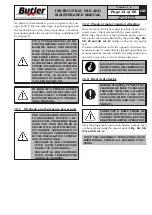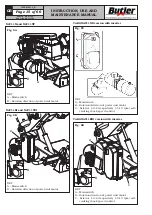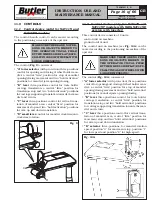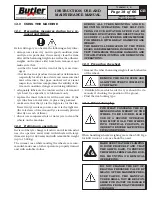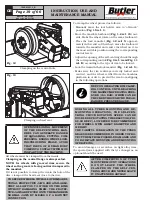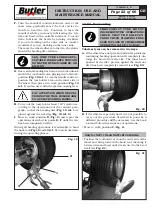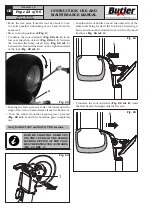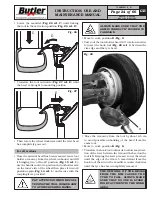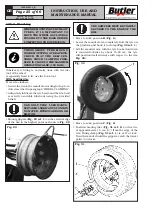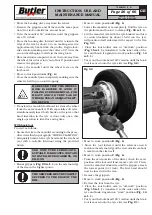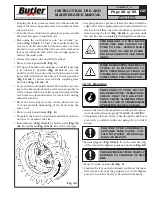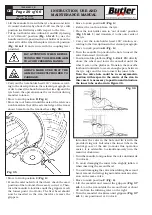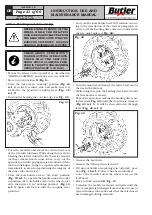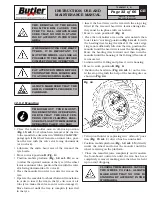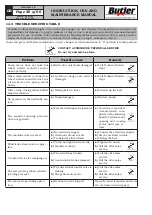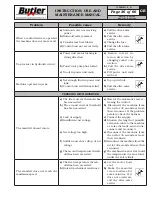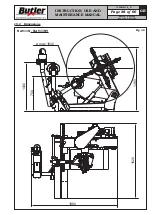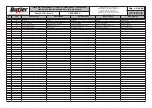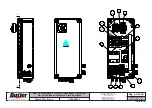
INSTRUCTION, USE AND
MAINTENANCE MANUAL
GB
Page 28 of 66
• Keeping the lever pressed, lower the wheel until the
edge of the rim is approximately 5 mm distant from
the hook tool.
• Turn the wheel clockwise keeping lever pressed until
the bead has gone completely out.
• Move away the tool holder arm in “out of work” po-
sition (
Fig.
_
15 ref.
_
1
); lower the mandrel until the
tyre rests on the movable footboard; exert a certain
pressure on it so that when the movable footboard
is moved outwards, this will create enough space to
extract the inner tube.
• Extract the inner tube and lift the wheel.
• Move to work position
D
(
Fig.
_
6
).
• Tilt up tool holder arm, unhook it and lift it placing
it in “off-work” position (
Fig.
_
15 ref.
_
1
); use the
handle control to position the tool holder arm on the
inner side of the wheel then place it in work position
(
Fig.
_
14 ref.
_
1
) and secure with the coupling lever
provided (
Fig.
_
1-2 ref.
_
8
).
• Carry out the tools holder head 180° rotation, accord-
ing to the descriptions in the relevant paragraph, in
order to insert the hook between the rim edge and the
tyre bead; the operation must be carried out during
mandrel rotation.
• Move the rim away from the tool by about 4-5 cm
to avoid possible unhooking of the bead from the
same tool.
• Move to work position
A
(
Fig.
_
6
).
• Translate the hook tool outwards until the reference
notch is 3 cm inside the rim.
• Insert the lever (
Fig.
_
34 ref.
_
1
) between rim (
Fig.
_
34
ref.
_
2
) and bead (
Fig.
_
34 ref.
_
3
) on the tool right.
Fig.
_
34
• Keeping the lever pressed, lower the wheel until the
edge of the rim is approximately 5 mm distant from
the hook tool then turn the mandrel counterclock-
wise keeping the lever (
Fig.
_
34 ref.
_
1
) pressed until
the tyre has been completely dislodged from the rim.
THE REMOVAL OF THE BEADS
FROM THE RIM CAUSES THE
TYRE TO FALL. ALWAYS MAKE
SURE THAT NO ONE IS STAND-
ING BY ACCIDENT IN THE WORK
AREA.
WHEN DEMOUNTING VERY HEAVY
TYRES, IT IS IMPORTANT TO
MOVE THE WHEEL AS CLOSE AS
POSSIBLE TO THE BASE BEFORE
COMPLETING THE OPERATION.
12.7.3 Mounting
THROUGHOUT TYRE MOUNT-
ING/DEMOUNTING OPERATIONS,
CHECK THAT THE SELF-CEN-
TRING CHUCK CLAMPING PRES-
SURE IS CLOSE TO THE MAXIMUM
OPERATING VALUE (150 BAR).
• Secure the rim to the mandrel according to the proce-
dure described in paragraph “WHEEL CLAMPING”.
• Adequately lubricate the tyre beads and the rim bead
seat with a suitable lubricant using the provided
brush.
USE ONLY TYRE LUBRICANTS.
SUITABLE LUBRICANTS CON-
TAIN NO WATER, HYDROCAR-
BONS, OR SILICON.
• Mount grippers (
Fig.
_
29 ref.
_
1
) on the external edge
of the rim in the highest point as shown in
Fig.
_
29
.
THE GRIPPERS MUST BE TIGHTLY
SECURED TO THE EDGE OF THE
RIM.
• Move to work position
B
(
Fig.
_
6
).
• Position the tyre on the footboard and lower the man-
drel (make sure that the grippers are in the highest
point) to hook the first tyre bead (internal bead).
7505-M001-3_B
NAV11N - NAV11NT
NAV11EI - NAV11TEI

